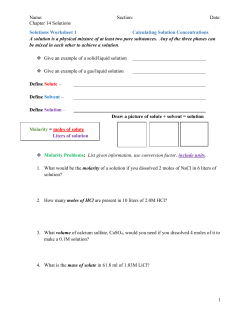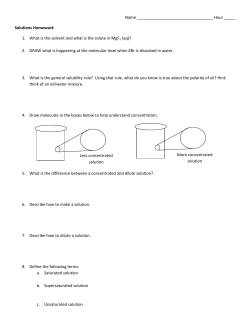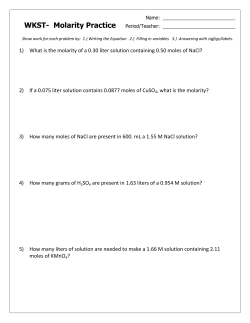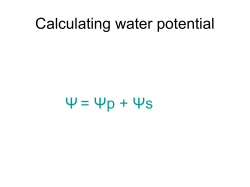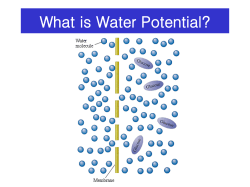
Solutions and Solubility
Solutions and Solubility Solutions • Solution – a homogenous mixture of a solute dissolved in a solvent. The solubility (ability to dissolve) of a solute in a solvent is dependent on the 1. Temperature For solid solutes: as temperature increases, solubility increases. For gas solutes: as temperature increases, solubility decreases. Solutions con 2. Pressure For solid solutes: as pressure increases, solubility remains the same. For gas solutes: as pressure increases, solubility increases 3. Nature of Solute/Solvent “Like dissolves in like.” Solute/Solvents cont. Solubility Summary Solute Type Nonpolar (Fat Grease) Polar Ionic (salt) High solubility-soluble Nonpolar solvent Soluble (soap) Insoluble insoluble Polar Solvent Insoluble (water) Soluble (water) Soluble (water) Low solubility-insoluble Solubility Curves • Shows the number of grams of solute that can be dissolved in 100.g of water at temperatures between 0 degrees C and 100 degrees C. • Each line represents the maximum amount of that substance that can be dissolved at a given temperature. • Lines that show an increase in solubility as temperatures increase represent solids being dissolved in water. • Lines that show a decrease in solubility as temperatures increase represent gases being dissolved in water. These are NH3, SO2, and HCl There are three types of solutions • 1. An unsaturated solution is a solution in which more solute can be dissolved at a given temperature. • 2. a saturated solution is a solution containing the maximum amount of solute that will dissolve at a given temperature. • 3. a supersaturated solution is a solution that contains more solute than would dissolve in a saturated solution at a given temperature. Solubility Rules • Not all ionic compounds are water soluble • There are some general rules for compounds that are water soluble: – Group 1 ionic cmpds and ammonium (NH4+) are always water soluble – Group 17 ionic cmpds are water soluble except when paired with Ag, Pb, and Hg ions – See Table F for full rules and exceptions Examples • • • • • • AgNO3 = water soluble AgCl = insoluble Na2S = soluble NaCl = soluble CaCO3 = insoluble AlPO4 = insoluble Precipitation reactions • Recall that double-replacement reactions have the general formula: AB(aq) + CD(aq) AD(aq) +CB(s) A precipitation reaction will take place if one or both of the products is listed as an insoluble solid. 2KI(aq) + Pb(NO3)2(aq) -> 2KNO3(aq) + PbI(s) • • • • • KI = soluble Pb(NO3)2 = soluble 2KNO3(aq) = soluble PbI(s) = insoluble solid In a precipitation reaction, two clear aqueous solutions are combined to form a cloudy, solid precipitate that can be collected by filtration. Concentrations of Solutions • Because solutions are homogeneous mixtures, their compositions can vary. Sometimes it is adequate to refer to a solution as dilute or concentrated. These are qualitative descriptions of concentration. It is more precise to describe the concentration of solutions in quantitative measures. Molarity • Molarity (M)- number of moles of solute in 1L of solution. Table T Molarity= moles of solute liters of solution Calculating molarity Highly concentrated HCl(aq) has a molarity of 12M This means there are 12 moles of HCl dissolved in 1 Liter of water 12M = 12 moles 1 Liter Sample Problem • How many grams of NaCl must be added to 1 Liter of water to make a 3M solution? • 3M = 3 moles NaCl I Liter 1 mole NaCl = 58g x 3moles = 174g NaCl Parts Per Million • Parts per million is another way of measuring the concentration of a solution • The general formula is: Parts per million = grams of solute x 1,000,000 grams of solution Parts per million example • 5 grams of NaCl is dissolved in 2.5L of water. What is the concentration of NaCl in parts per million (ppm)? • Remember 1mL water = 1 g ppm = 5g NaCl x 1,000,000 = 2000 ppm 2500 g H2O Colligative Properties Freezing and boiling points of water change when salts (nonvolatile solutes) are added. Colligative properties depend on the number of particles in a substance 1. Freezing Point Depression: when any salt is added to water, the freezing point of the water decreases. Freezing point of pure water= 0 degrees C Freezing point of salt water (NaCl solution)= -21°C (-6°F) under controlled lab conditions In the real world, on a real sidewalk, sodium chloride can melt ice only down to about -9°C (15°F) Molecular vs. Ionic • When one mole of sucrose is dissolved in water, one mole of particle is produced in solution: C12H22O11(s) C12H22O11(aq) • When one mole of an ionic substance is dissolved in water, the results are different. The ionic substance dissociates into individual ions: NaCl(s) Na(aq) + Cl (aq) • The greater number of ions, the lower the freezing point. Boiling Point Elevation • When any salt is added to water, the boiling point of the water increases. • Boiling point of pure water= 100° C • Boiling point of salt water solution increases
© Copyright 2025


